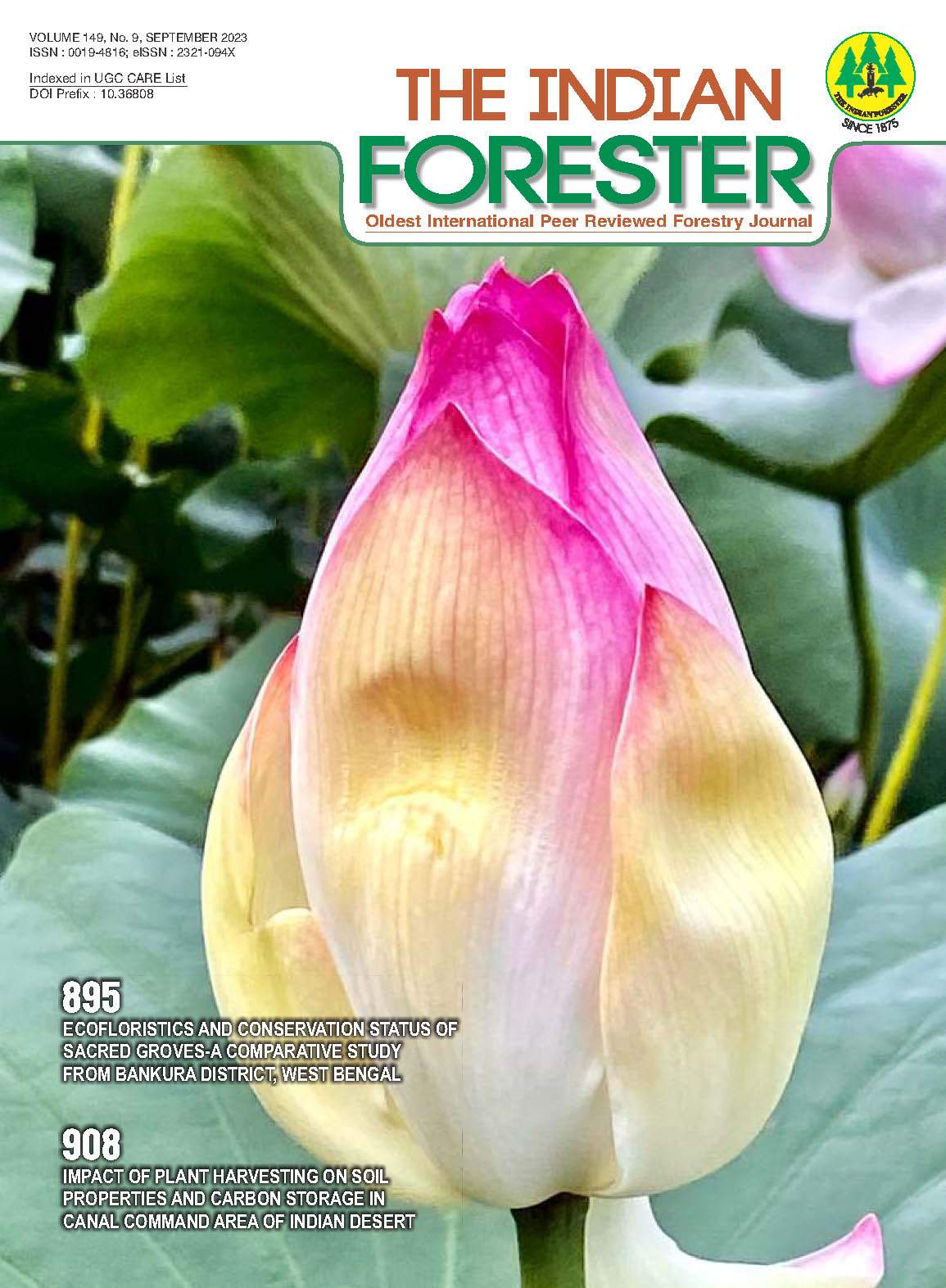Role of Participatory Forest Management (PFM) Institutions in the Management of Non-Timber Forest Products: A Roadmap from Kerala
DOI:
https://doi.org/10.36808/if/2023/v149i9/169470Keywords:
Non-Timber Forest Products, Participatory Forest Management, PFM Institutions, VSS & EDC, Kerala Forest Department, Forest-Dependent Communities, Livelihood.Abstract
Non-timber forest products (NTFP) provide both food and income to forest-dependent communities. The average daily revenue from NTFP gathering surpassed that of Kerala's average agricultural wage labour. The forest department, through its Participatory Forest Management institutions (VSS and EDC), provides necessary operational and technical assistance in the gathering and trading of NTFPs collected by native forest-dependent communities. The objective of the study is to analyze the strategies and projects employed by the forest department in the management of NTFPs in co-corporations with forest-dependent communities and PFM institutions. The NTFPs collected through PFM institutions are fresh and pure from the forests and are not been tampered with. “Vanasree†is a unique venture established by the Kerala Forest and wildlife department under the State Forest Development Agency (SFDA) for the sale of Non-Timber Forest Produce collected by various forest-dependent communities. Virtual Go Down is a recently envisaged scheme of the Department of Forest and Wildlife to ensure uniformity in the management of NTFP under a single umbrella scheme. Forest Department plays a crucial role in supporting the livelihoods of forest-dependent communities by establishing and strengthening Participatory Forest Management (PFM) institutions. These institutions enable local communities to participate in sustainable forest management practices and utilize forest resources while ensuring their sustainable conservation.References
Alex A. and Vidyasagaran K. (2016). The marketing of nontimber forest products in the Western Ghats region of Attappady, Kerala. Economic Affairs, 61(3): 355-363.
Alexander, George. (2021). Mattathinte Mathrukaayi Mancode (Malayalam). Aranyam Magazine. Forestry Information Bureau. Government of Kerala, 41(11-12): 65-68.
Appiah D.O. (2009). Personifying sustainable rural livelihoods in forest fringe communities in Ghana: A historic rhetoric. Journal of Food, Agriculture & Environment, 7(3&4): 873-877.
Areki F. and Cunningham A.B. (2010). Fiji: Commerce, Carving and Customary Tenure. In: Wild Product Governance: Finding Policies that Work for Non-Timber Forest Products, Laird, S.A., R.J. McLain and R.P. Wynberg (Eds.). Earthscan, London, UK., pp: 229-242
Balooni K. (2002). Participatory Forest Management in India: An Analysis of Policy Trends Amidst ‘Management Change’, policy trend report.
Belcher B.M. and Vantomme P. (2003). What isn't an NTFP? The International Forestry Review, 5(2): 161-168.
FAO (2012). State of the World’s Forests 2012. FAO, Rome, http://www.fao.org/3/a-i3010e.pdf Accessed on July 2015.
George, Lijo. (2021). Vana Paripalanathil Koottaymayuda Karuthu (Malayalam). Aranyam Magazine. Forestry Information Bureau. Government of Kerala, 41(11-12): 44-51.
Government of India (2020). Mera Van-Mera Dhan-MeraUdyam. Trifed. Ministry of Tribal affairs, https://tribal.nic.in/downloads/ Livelihood/ Reports/200%20DAYS%20of%20 VANDHAN%20Implementation%20_TRIFED_31-March.pdf
Government of Kerala (2013). Economic review, Kerala State Planning Board.
Gubbi, S. and MacMillan D.C. (2008). Can non-timber forest products solve livelihood problems. A case study from Periyar Tiger Reserve, India. Oryx, 42(2): 222-228.
Gupta A.K., Sharma M.L. and Limje S. (2018). Economic empowerment of tribes through Non-Timber Forest Products (NTFPS) in Chhattisgarh state. Indian Journal of Extension Education, 54(4): 139-146.
Gurukkal R. (2003). The eco-development project and the socioeconomics of the fringe area of the Periyar Tiger Reserve: a concurrent study. Report, School of Social Sciences, Mahatma Gandhi University, Kottayam, India, 126-139.
Keenan R.J., Reams G.A., Achard F., de Freitas J.V., Grainger A. and Lindquist E. (2015). Dynamics of global forest area: Results from the FAO Global Forest Resources Assessment 2015. Forest Ecology and Management, 352: 9-20.
Kerala Forest Department (2006). Mazhayil Kathunna Panthamgal (Malayalam). Best edition Trivandrum.
Kerala forest statistics report (2015). Kerala Forest Statistics Report. Kerala forest and wildlife department, Government of Kerala, 26-30.
Krishnakumar J., Yanagida J.F., Anitha V., Balakrishnan R. and Radovich T.J. (2015). Non-timber forest products certification and management: Asocioeconomic study among the Kadars in Kerala, India. Environment, development and sustainability, 17(4): 837-858.
Malhotra K.C. and Poffenberger M. (1989). Forest regeneration through community protection: the West Bengal experience: proceedings of the working group meeting on forest protection committees, Calcutta, June 21-22, 1989.
Ninan K.N. (2009). Non-timber forest products and biodiversity conservation—A study of tribals in a protected area in India. In K. N. Ninan (Ed.), Conserving and valuing ecosystem services and biodiversity: economic, institutional and social challenges pp. 99–112. London: Earthscan.
Pandey A.K., Tripathi Y.C. and Kumar A. (2016). Non-timber forest products (NTFPs) for sustained livelihood: Challenges and strategies. Research Journal of Forestry, 10(1): 1-7.
Prasad R. and Kant S. (2003). Institutions, forest management, and sustainable human development–experiences from India. Environment, Development and Sustainability, 5: 353-367.
Samraj T. (2010). The ayurvedic industry and its implications on NTFP sustainability. Indigenous people and forests in India—View from a network. Keystone Foundation: Tamil Nadu, 12-18.
Sharma C. and Yadav P. (2021). Marketing Channel for Non-Timber Forest Product (NTFP) In Chhattisgarh. Frontiers in Science and Technology in India: An Overview, 42.
Shylajan C.S. and Mythili G. (2007). Community dependence on non-timber forest products: A household analysis and its implication for forest conservation. Indira Gandhi Institute of Development Research, Mumbai, India, 2-29.
Unnikrishnan P.N (2010). Forest Biodiversity conservation and management through PFM (Malayalam) (Ed), PFM Cell, Eco-Development and Tribal Welfare Wing & Kerala Forest Research Institute (KFRI), 18-33.
Downloads
Downloads
Published
How to Cite
Issue
Section
License
Unless otherwise stated, copyright or similar rights in all materials presented on the site, including graphical images, are owned by Indian Forester.





